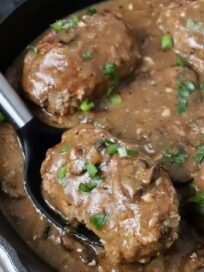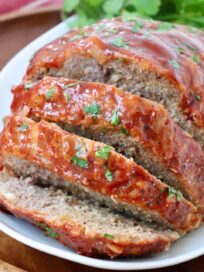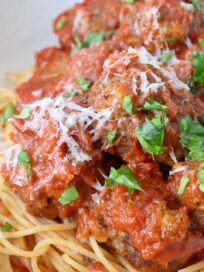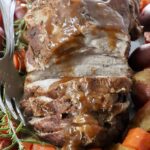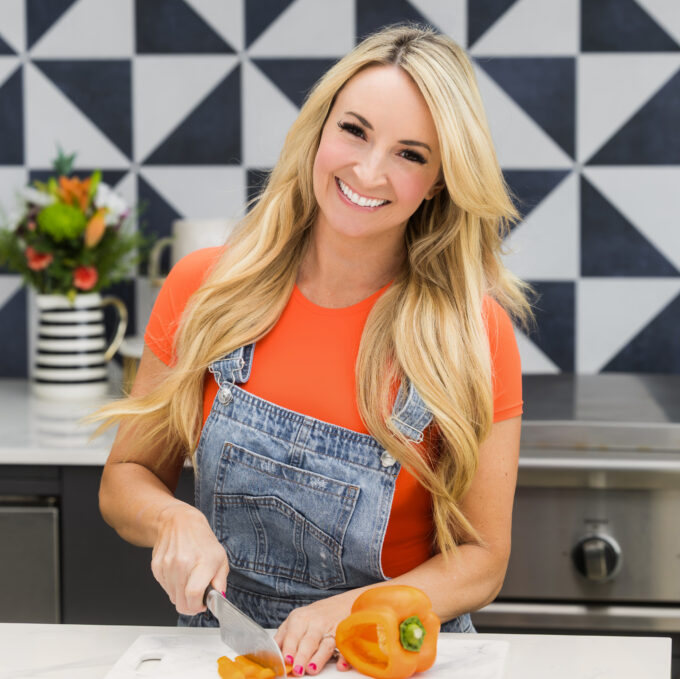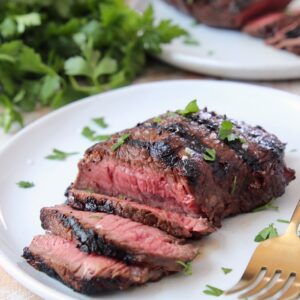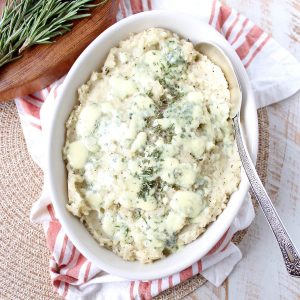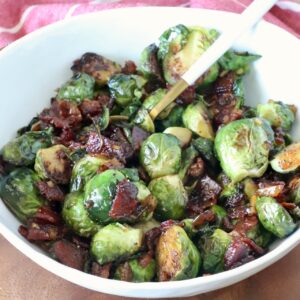Pork Roast
This post may contain affiliate links.
Make a juicy, tender, and flavorful Pork Roast with this easy recipe! This oven roasted pork shoulder makes for a delicious family meal. It’s covered in a homemade pork seasoning, then slow cooked in the oven with beef stock and apple juice for a sweet and savory flavor. Vegetables are roasted with the pork shoulder, so when the cooking time is up, a full meal is ready!
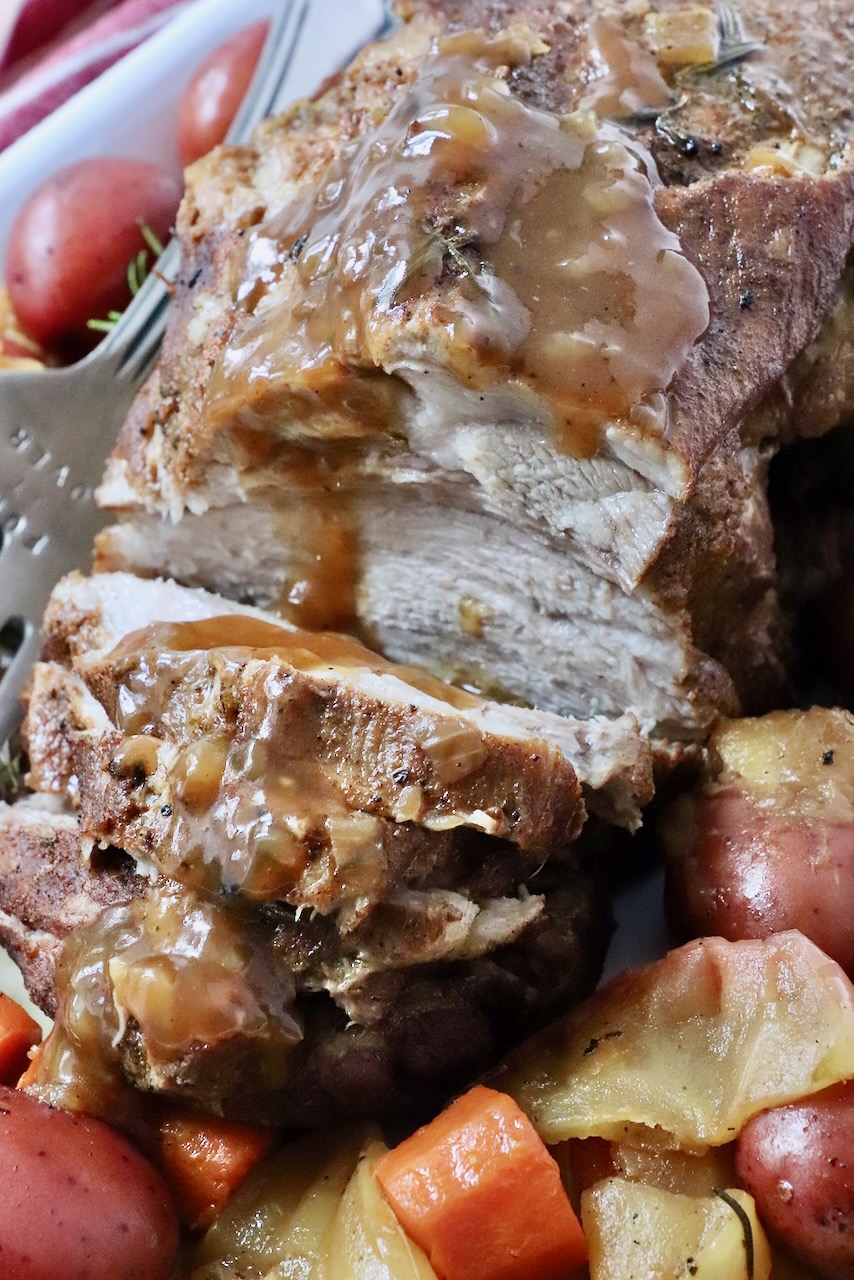
Why this pork roast recipe is the best
After perfecting my pot roast recipe, I decided it was time to perfect a pork roast recipe. While the two recipes are similar, I added some different ingredients and seasonings to this recipe that pair perfectly with the pork.
If you’re looking for a delicious Sunday dinner, then look no further than this oven roasted pork roast recipe. It really is the best recipe out there and here’s why!
- The seasoning adds so much flavor to the pork. Unlike some pork roast recipes that just call for seasoning the pork with salt and pepper, I used my homemade pork seasoning to add a ton of flavor to the pork. It’s a simple mix of pantry staple herbs and spices that you can can keep in the pantry for up to 6 months and use on a variety of different pork recipes.
- The gravy, made with the drippings in the pot, is so delicious! After the roast cooks, simply strain out a cup of the liquid from the pot, heat it up on the stove, then mix in a little cornstarch slurry. The combination of the pork drippings, beef stock and apple juice create a slightly sweet, salty, and savory sauce to drizzle over the pork roast.
- It’s juicy and tender! Slow cooking the pork roast in the oven for just the right amount of time results in pork that’s tender and juicy, never dried out or tough!
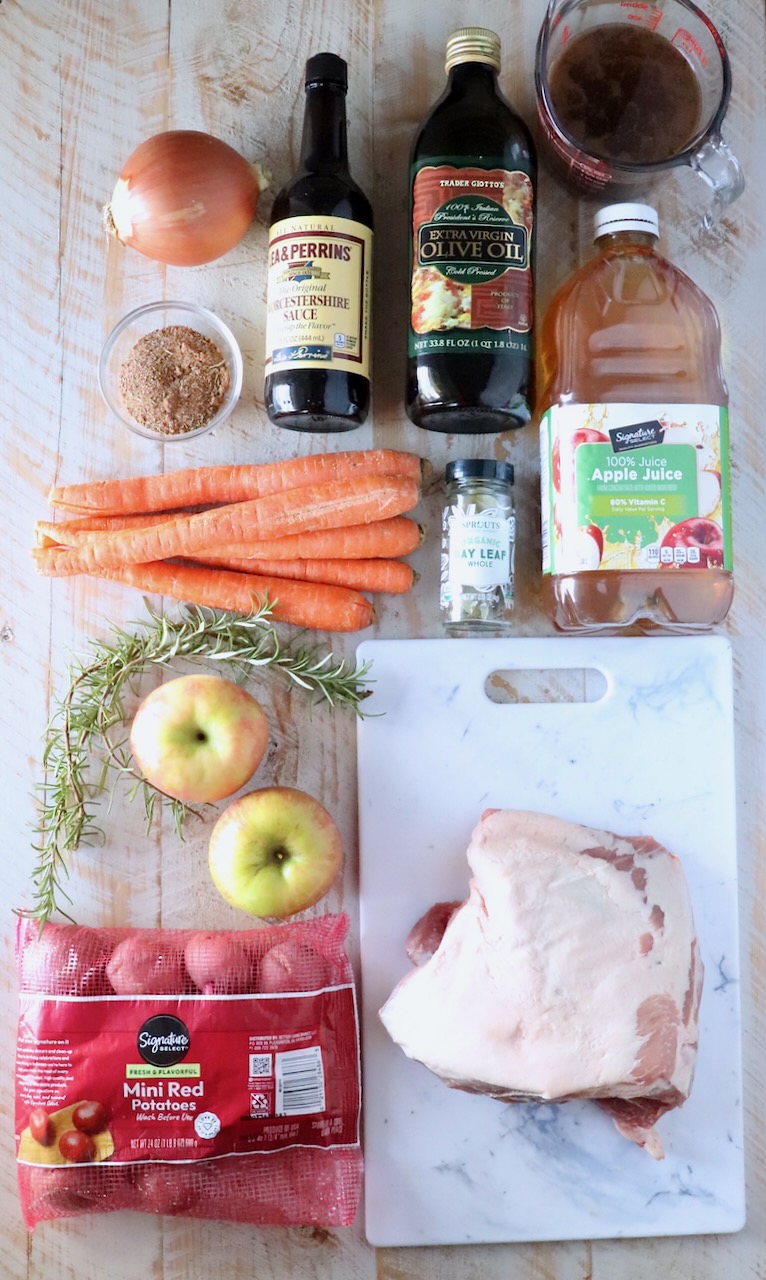
Ingredients
Here I explain the best ingredients for this pork roast recipe, what each one does, and substitution options. For the exact ingredient measurements, see the recipe card at the bottom of this post.
- Pork shoulder – a pork butt and pork shoulder both come from the shoulder of the pig. They can be used interchangeably in this recipe. You might also find this cut of meat labeled as a “boston butt” or “picnic shoulder” at the grocery store. You can use a bone-in pork shoulder, or boneless pork shoulder. Slow roasting a shoulder with the bone will give it more flavor, but it will take a little longer to cook. Using a boneless pork shoulder makes it easier to slice and serve. The choice is up to you! You want a thin layer of fat on top of the pork for flavor, but if it’s more than a thin layer, you’ll want to trim it down before cooking.
- Pork seasoning – click the link for my homemade pork dry rub. While I originally made it to go on pork chops, I now use it to season all different cuts of pork.
- Olive oil
- Beef stock – you can purchase beef broth in a can or box at the grocery store, or make your own beef stock at home. I found this Custom Culinary Beef Base at a restaurant supply store in San Diego and love it so much. You can order it online. It’s a little expensive for beef bouillon, but oh my gosh the flavor is so good.
- Apple juice – if you prefer a savory pork roast without any sweetness, replace the apple juice with more beef stock.
- Worcestershire sauce – this amazing condiment adds so much flavor to the pork shoulder roast. It’s sweet, salty, tangy and adds a layer of umami flavor to the dish. If you don’t have any Worcestershire sauce, you can use soy sauce instead.
- Onions – you’ll need two cups of yellow onions for this recipe, which is equal to one large onion.
- Carrots – I recommend peeling whole carrots and cutting them into two inch pieces. Cutting the carrots too small will result in them overcooking in the liquid with the pork roast. This can cause them to fall apart in the dish, or become very mushy.
- Mini red potatoes – after making pork roast in the oven several times, I’ve found that the taste and texture of the potatoes is much better if you keep them whole while they cook with the pork. This will prevent them from falling apart in the liquid. When using whole potatoes, you’ll want small potatoes, usually labeled as mini potatoes, baby potatoes, or fingerling potatoes.
- Fresh rosemary – you can also use fresh thyme sprigs if you prefer.
- Bay leaves – adding a couple of leaves to the cooking liquid before braising the pork shoulder will add another layer of flavor to the dish.
- Honey crisp apples (optional) – I like to add apples to the pot during the last 30 minutes of the cook time. This will soften the apples, but ensure that they don’t fall apart. Apples and pork make a great pairing, but the addition is optional.
- Cornstarch (optional) – to make gravy out of the pan drippings after you cook the pork roast.
Instructions
I’ve included step by step photos below to make this recipe super easy to follow at home. For the full detailed recipe instructions, scroll to the recipe card at the bottom of this post.
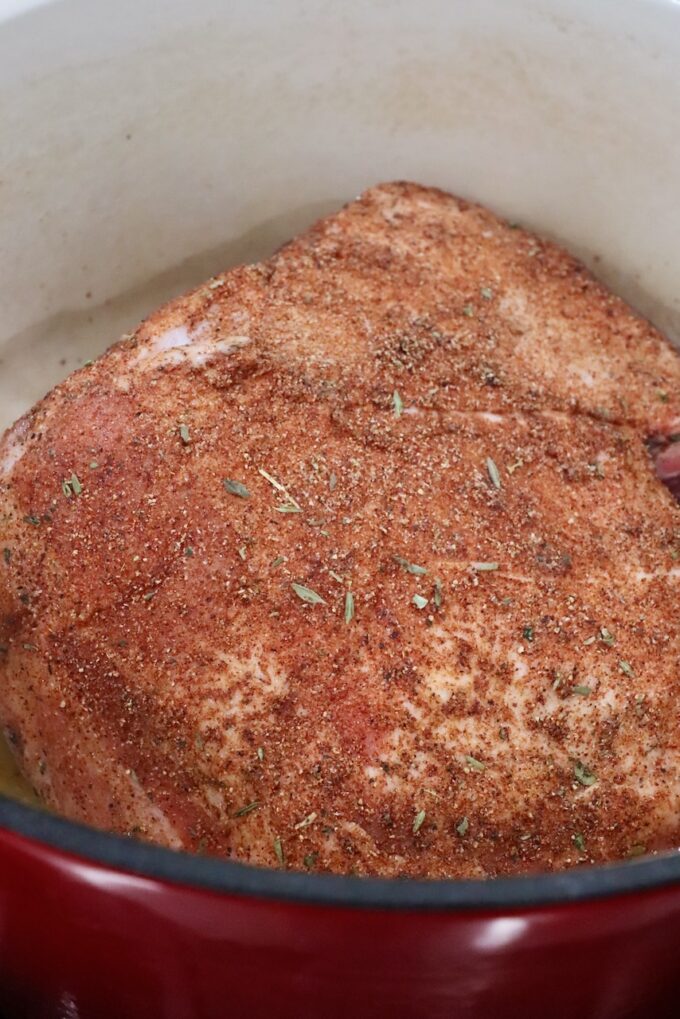
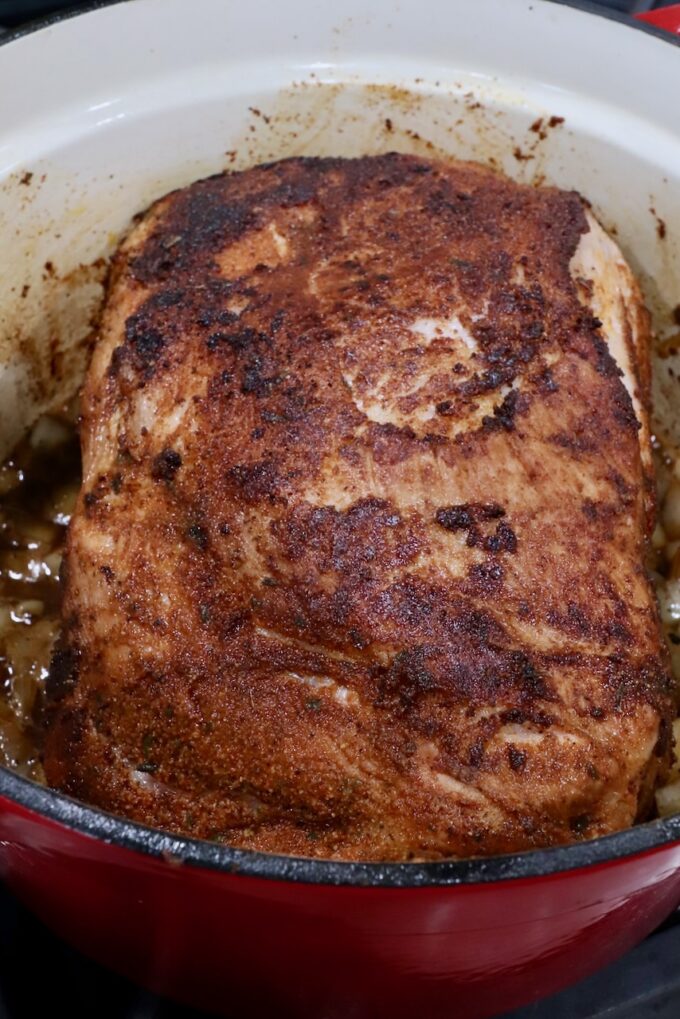
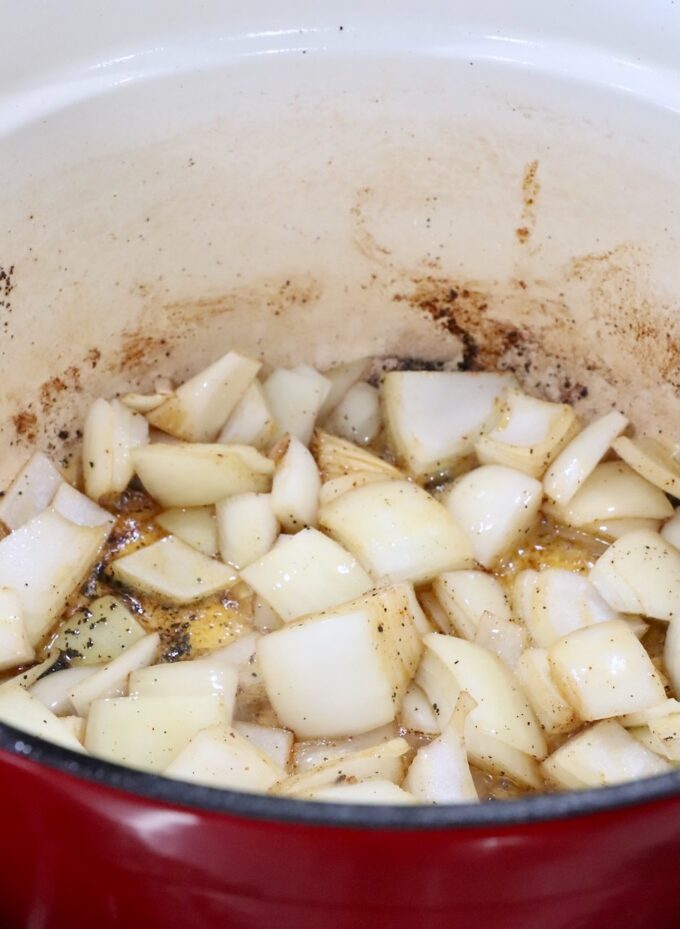
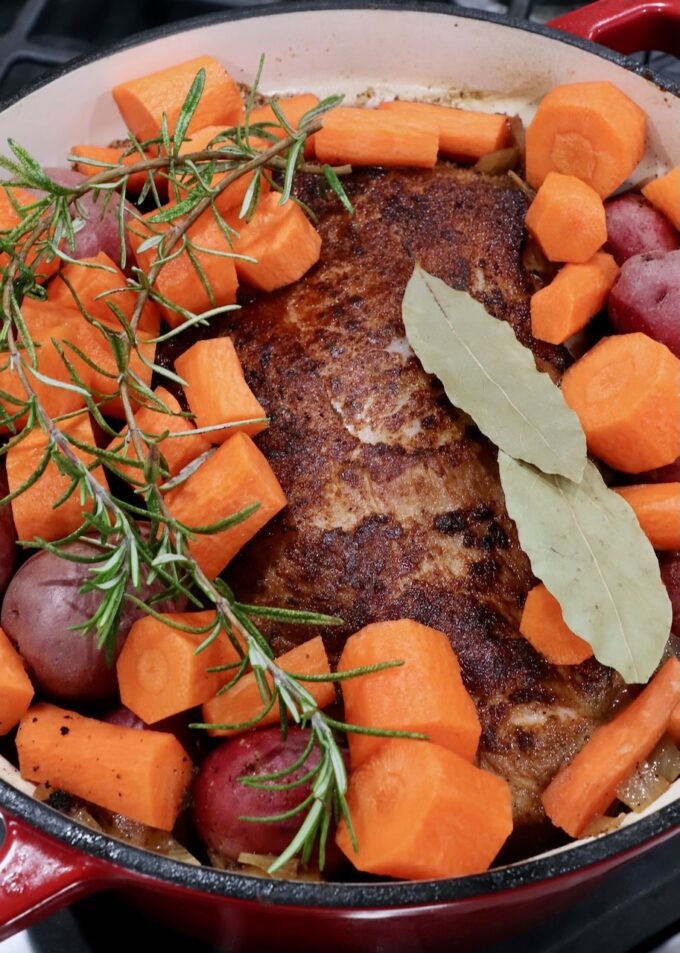
- Season the pork shoulder. Place the pork shoulder on a large cutting board and pat dry with paper towels. If needed, trim any excess fat on the pork. Season on all sides with the pork seasoning.
- Sear the pork shoulder. Heat olive oil in a large oven-safe pot (I used a 7 quart dutch oven) on the stove over high heat. Add the seasoned pork and sear on all sides for 2 minutes per side. Remove the pork from the pot and set it aside.
- Cook onions in the pot. Add more olive oil to the pot. Add onions and cook for 5 minutes. Pour ¼ cup beef stock into the pot and stir to deglaze the bottom of the pan, scraping up any browned bits from the bottom of the pan. Add the pork back to the pot.
- Add the liquid, veggies, and herbs. Pour the rest of the beef stock into the pot, along with the apple juice and Worcestershire sauce. Add mini potatoes and diced carrots around the pork.The vegetables do not need to be submerged in the liquid. They will steam in the dutch oven as they cook with the pork roast. Bring the liquid in the pot to a boil. Once boiling, add fresh rosemary and bay leaves. Cover the pot with a lid, or a tight-fitting piece of foil, and transfer it to a preheated oven at 325°F.
- Roast the pork. Once in the oven, a 4-6 pound pork shoulder should roast for 90 minutes. See the notes section below for timing based on the size of the pork shoulder. After 90 minutes, remove the lid, add sliced apples to the pot and continue to cook for another 30 minutes, or until the pork reaches an internal temperature of 180°F. The internal temperature will rise 5-10 degrees as it rests. Remove the pork from the oven. Use tongs to remove and discard the bay leaves and rosemary sprigs. Transfer the pork shoulder to a cutting board, loosely tent with foil and let it rest for 20 minutes before slicing and serving.
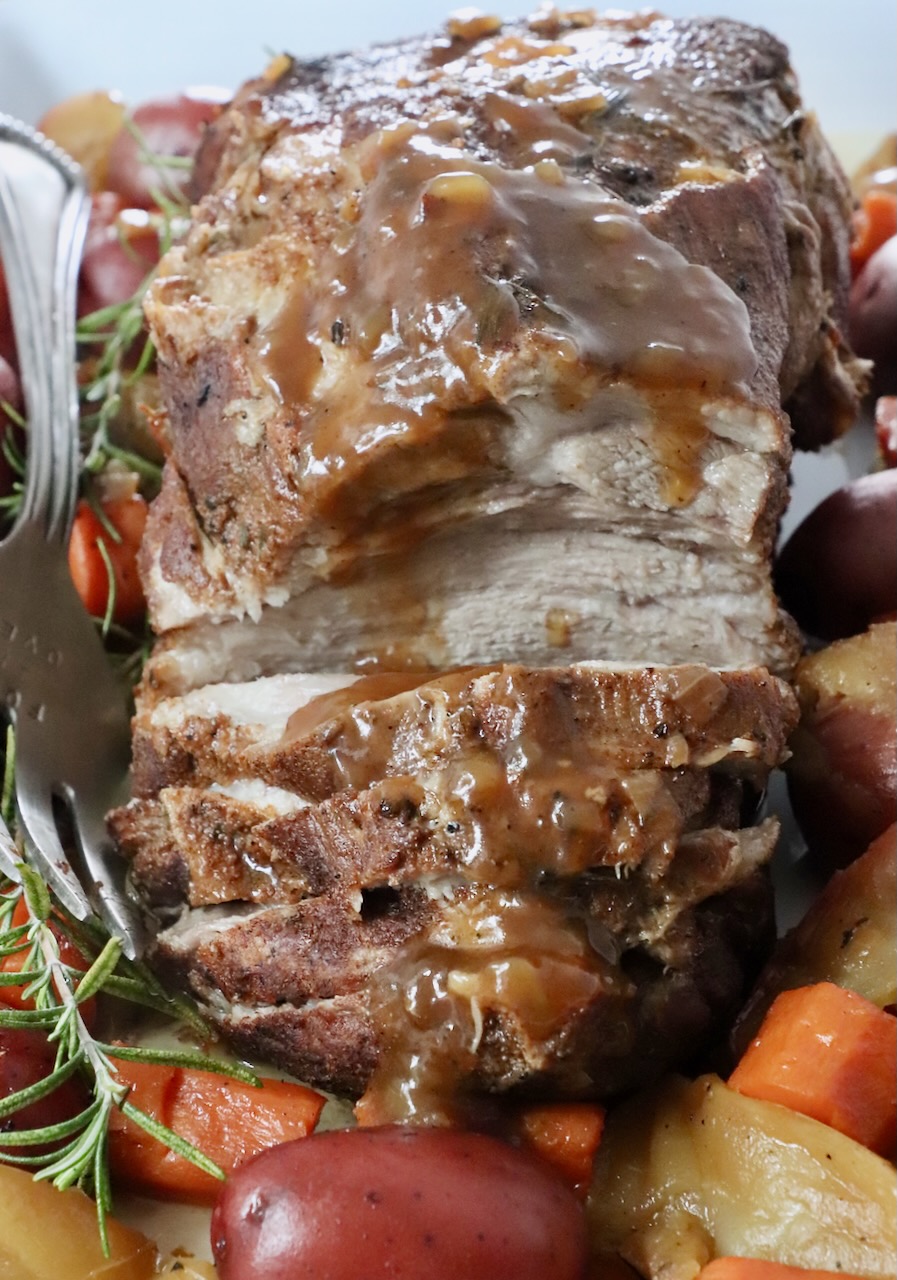
How to make gravy with the drippings
If you want to make a gravy with the liquid from the pot, follow these instructions. Just a personal note, I absolutely love this gravy and would never serve the pork roast without it. It’s super easy to make and can be made while the pork is resting, so basically what I’m saying is that I highly encourage the making of this gravy!
- Use a slotted spoon to move the vegetables from the pot to a serving platter. Cover tightly with foil to keep the vegetables warm while you’re resting the pork and preparing the gravy.
- Pour the liquid from the pot through a fine mesh strainer and into a large bowl.
- Measure out a cup of the liquid, then add it to a small pot on the stove over high heat. Bring to a boil.
- While waiting for the liquid to boil, combine 1 tablespoon cornstarch and 1 tablespoon water in a small bowl to make a cornstarch slurry.
- Once the liquid is boiling, pour the cornstarch slurry into the pot and stir quickly to combine. Let it simmer for 1-2 minutes, then remove the pot from the stove.
This gravy should have a “glaze-like” consistency. Since it’s made with the liquid in the pot, that contains apple juice, beef stock and pork drippings, it’s a little sweet and a little salty, and has a really deep, rich flavor.
Temperature and timing for roasting pork
This recipe has been tested on boneless and bone-in pork shoulders, ranging anywhere from 4 to 6 pounds in weight. If you’re using a boneless pork shoulder that’s close to 4 pounds, I recommend adding the apples after 75 minutes, then checking the internal temperature of the pork with a meat thermometer after another 30 minute cook time.
If you’re using a bone-in pork shoulder that’s closer to 6 pounds, I recommend roasting it for 90 minutes, adding the apples, then checking the internal temperature of the pork after another 30 minute cook time.
I recommend cooking to temperature not to time, so that the pork is both juicy and tender.
I’ve found that somewhere between 180-190°F is the perfect temperature for roast pork that’s both tender and juicy. While I only cook a pork tenderloin to an internal temperature of 145°F. This temperature will not result in a tender pork shoulder.
On the other hand, when cooking a pork shoulder to shred and make pulled pork, I like to cook it to an internal temperature of 205°F. But when preparing this pork roast for slicing, cooking it to 205°F resulted in a drier piece of meat. Thus, I found the perfect middle ground between 180-190°F where the pork is both tender and moist.
If the pork has not reached your desired temperature after the cook time, I recommend checking the internal temp every 10 minutes with an instant-read thermometer, until you reach the desired temp.
Storage and reheating
Store leftover pork roast in an airtight container in the refrigerator for up to 5 days. You can reheat it on the stove, or in the oven.
If reheating a slice of the pork roast, I recommend reheating it for 2-3 minutes per side in a skillet on the stove over medium-high heat.
If reheating a large portion of the roast, I recommend wrapping it in foil, then placing it in a 350°F oven for 15-20 minutes, or until heated through.
You can also shred the leftover pork apart, heat it up on the stove, or in the microwave, then toss it with bbq sauce to make delicious sandwiches.
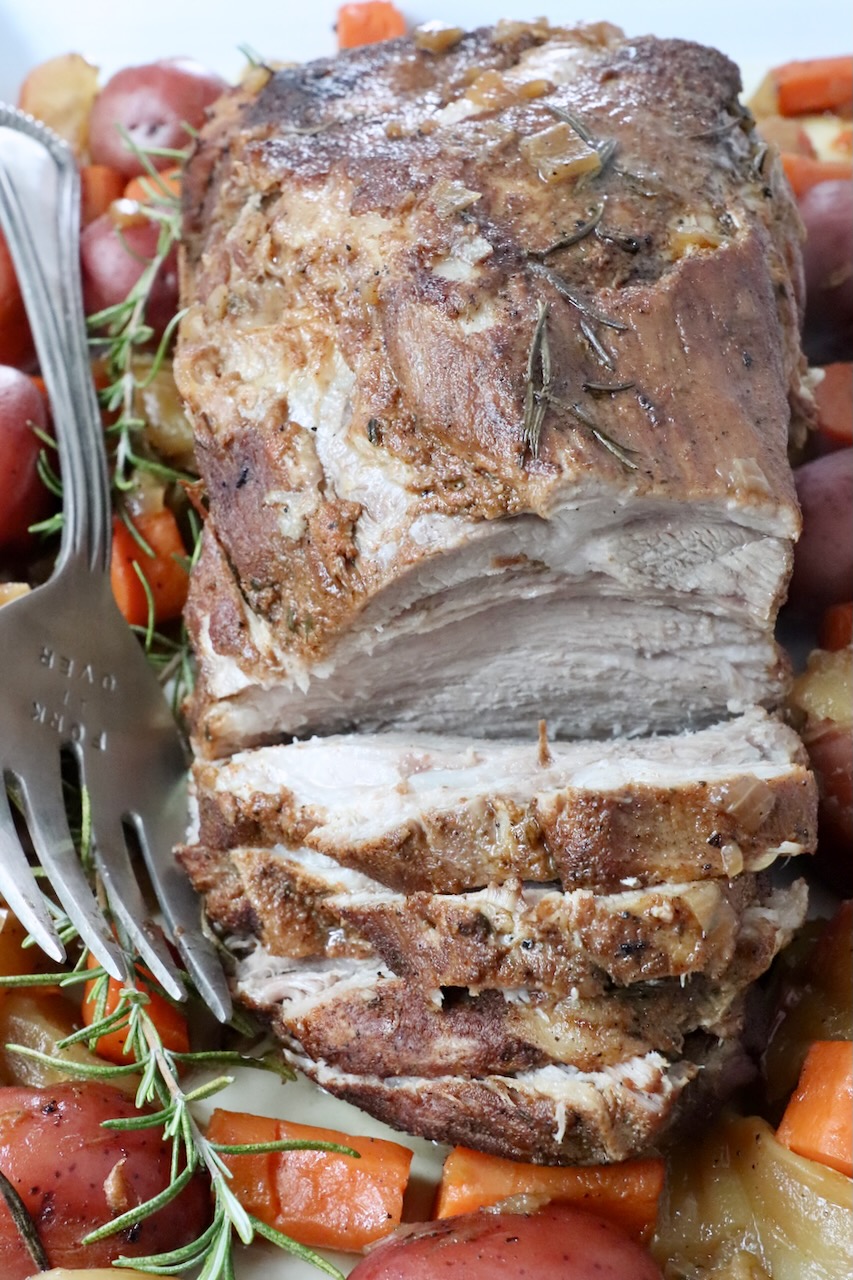
More comfort food recipes
Try these other classic comfort food recipes for your next family dinner!
Pork Roast
Ingredients
- 4-6 pound pork shoulder, boneless or bone-in, see notes below
- 3 tablespoons pork chop seasoning, click link for the recipe
- 3 tablespoons olive oil, divided
- 1 ½ cups beef stock
- 1 ½ cups apple juice
- 1 tablespoon worcestershire sauce, or soy sauce
- 2 cups onions, large dice
- 1 pound carrots, peeled and cut into 2 inch pieces
- 1 ½ pounds mini red potatoes
- 2 sprigs fresh rosemary
- 2 bay leaves
- 2 honeycrisp apples, cored and sliced into wedges
- 1 tablespoon cornstarch, optional – for gravy
Instructions
- Preheat the oven to 325°F.
- Pat the pork dry with paper towels. If needed, trim any excess fat on the pork, then rub the pork shoulder on all sides with the pork chop seasoning.
- Heat 2 tablespoons olive oil in a 7 quart (or larger) oven-safe pot, or dutch oven, on the stove over high heat.
- Add the seasoned pork shoulder and sear on all sides for 2 minutes per side. Remove the pork from the pot and set it aside.
- Add the remaining 1 tablespoon olive oil to the pot. Add the onions and cook for 5 minutes. Pour ¼ cup beef stock into the pot and stir to deglaze the bottom of the pan, scraping up any browned bits from the bottom of the pan. Add the pork back to the pot.
- Pour the rest of the beef stock into the pot, along with the apple juice and worcestershire sauce.
- Add the potatoes and carrots around the pork. The vegetables do not need to be submerged in the liquid. They will steam in the dutch oven as they cook with the pork roast.
- Bring the liquid in the pot to a boil. Top with the fresh rosemary sprigs and bay leaves.
- Cover the pot with a lid, or a tight-fitting piece of foil, and place in the oven for 90 minutes.
- After 90 minutes, remove the lid, add the apples and continue to cook for another 30 minutes, or until the pork reaches an internal temperature of 180°F. The internal temperature will rise 5-10 degrees as it rests.
- Remove the pork from the oven. Use tongs to remove and discard the bay leaves and rosemary sprigs. Transfer the pork shoulder to a cutting board, loosely tent with foil and let it rest for 20 minutes before slicing and serving.
Make a gravy for the pork (optional)
- While the pork rests, you can prepare a gravy on the stove with the pan drippings. Start by using a slotted spoon to move the vegetables from the pot to a serving platter. Cover tightly with foil to keep the vegetables warm while you’re resting the pork and preparing the gravy.
- Pour the liquid from the pot through a fine mesh strainer and into a large bowl. Measure out a cup of the liquid, then add it to a small pot on the stove over high heat. Bring to a boil.
- While waiting for the liquid to boil, combine 1 tablespoon cornstarch and 1 tablespoon water in a small bowl to make a cornstarch slurry.
- Once the liquid is boiling, pour the cornstarch slurry into the pot and stir quickly to combine. Let it simmer for 1-2 minutes, then remove the pot from the stove. Serve the gravy on the side of the pork roast, or drizzled on top.
Notes
- When selecting a pork shoulder, remember that bone-in pork will give you more flavor, but it will take a little longer to cook. Using a boneless pork shoulder takes less time to cook and makes it easier to slice and serve. The choice is up to you! You want a thin layer of fat on top of the pork for flavor, but if it’s more than a thin layer, you’ll want to trim it down before cooking.
- I recommend planning for a half-pound of meat per person, so if you’re roasting a 4 pound pork shoulder, it will feed 8 people. If you’re roasting a 6 pound pork shoulder, it will feed 12 people. But remember, it also makes great leftovers!
- Store any leftovers in an airtight container in the fridge for up to 5 days. I recommend reheating the pork in a skillet on the stove, or wrapped in foil in the oven.
- You can braise the pork roast on the stove, instead of in the oven, if you prefer. Simply cover the pot, set the stovetop temperature to medium-low heat and allow the pork to simmer in the liquid for 2 hours on the stove.
- If you don’t want to cook the pork in apple juice, you can simply double-up on the beef stock.
Nutrition Facts
We are a participant in the Amazon Services LLC Associates Program, an affiliate advertising program designed to provide a means for sites to earn advertising fees by advertising and linking to amazon.com.





